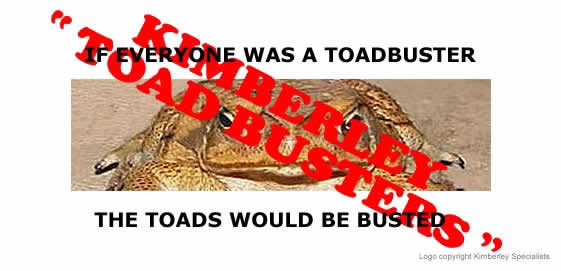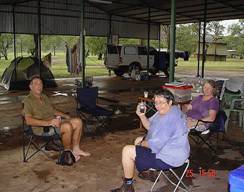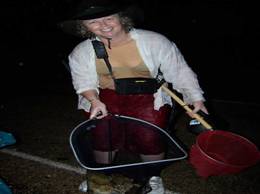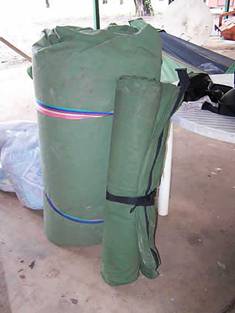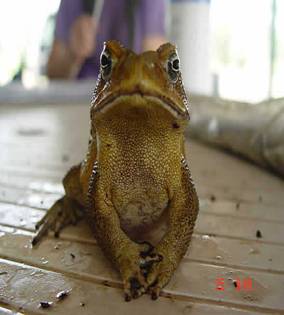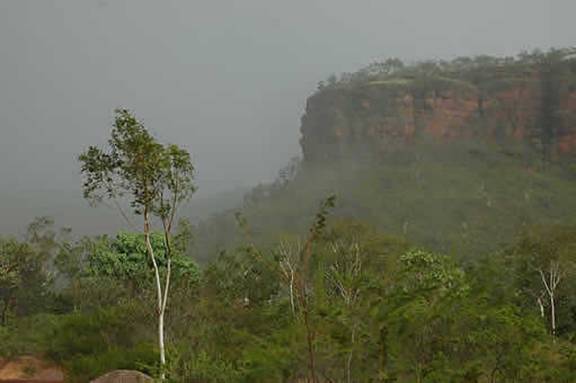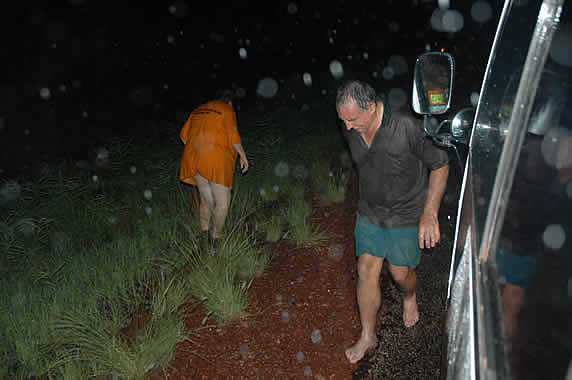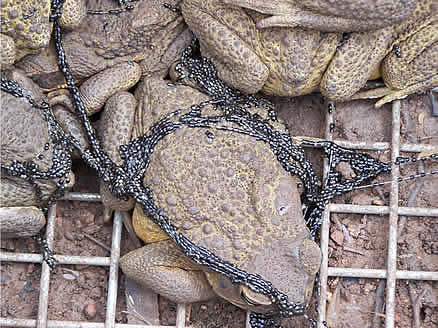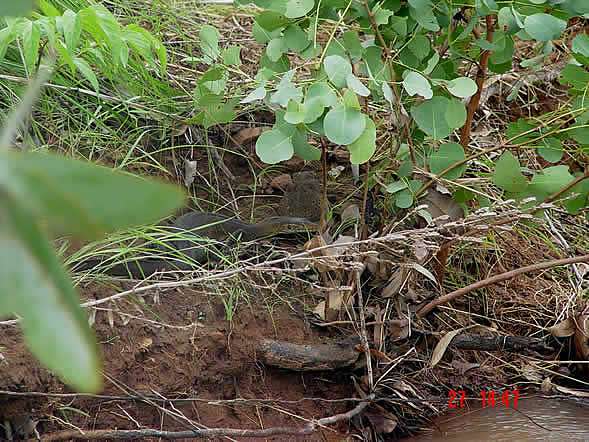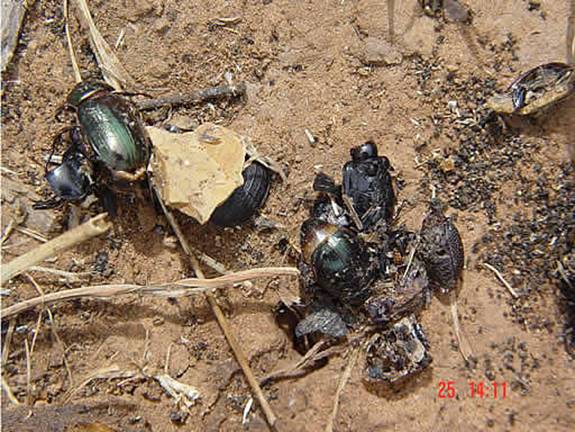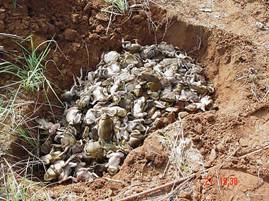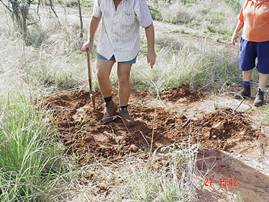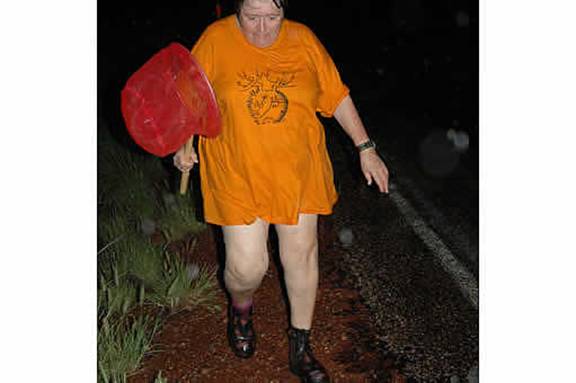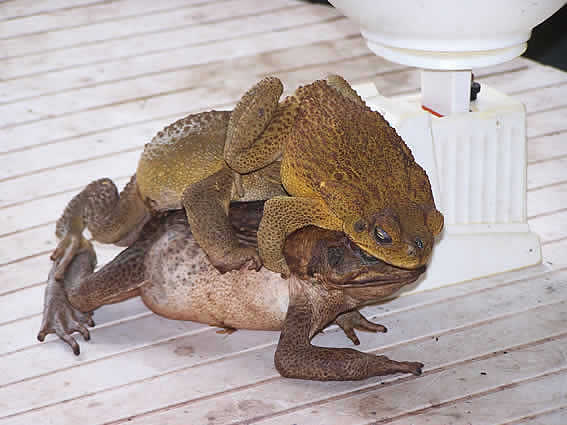A heartfelt cry from the Kununurra Community to the Nation. We will Stop the Cane Toads getting into WA! |
 |
 |
 |
 |
 |
|---|
KIMBERLEY SPECIALISTS Volunteer CANE TOAD Training & Toad Busting NEWSLETTER No.9
WWW.CANE TOADS.COM.AU The Cane Toad is a Key Threatening Process to the Australian Nation. Federal Government 12 April 2005 IF EVERYONE WAS A TOADBUSTER www.kimberleyspecialists.com.au www.kimberleyspecialists@westnet.com.au
|
Christmas Toadbusting! 24th to the 27th. hat a Toad Busting experience our Christmas weekend turned out to be! Not only did we experience torrential rainfall, major electrical storms with most of the time being wet and cold or steaming hot, but we actually located a major front line cane toad breeding colonisation front. We also identified a second ‘wave’ of adult mature males coming across the Victoria River to the Roadhouse.
Photo by Pam Steele. This was the type of weather that greeted our team over the Christmas toad busting! The Christmas Toad Buster Team! The team for the Christmas weekend consisted of me, Del Collins, Dean Goodgame (Kununurra) and Pam Steele (Broome). Pam stayed on for a further 3 nights and was joined by Robyn Marius from Perth . Chris Spur (Kununurra) also spent an overnight in the field just prior to our Christmas team arriving. This has meant we (the Kimberley Toad Busters) were able to consistently monitor and bust toads for 8 consecutive days. And what amazing results we have managed to achieve. The sheer numbers of toads that have moved across the Victoria River in the space of a few days has been staggering. It is also evident that many of the toads (predominantly male) had been ‘hiding’ in and around the Escarpment Creek and walking trial area just waiting for the right conditions to begin calling the females for breeding (shades of The Day of the Triffids/oops cane toads). Had we (the Kimberley Toad Busters) decided to take Christmas off we may have missed the opportunity of ‘pinpointing’ not only the ‘breeding’ area but also the behavior of toads when the first ‘real’ wet seasons rains arrived. While the single ‘Christmas’ event of finding a major wet season breeding area was important, the additional data collected by Chris Spur and the follow-up team, Pam Steele and Robyn Marius (after our Christmas team left the area to return to Kununurra) has been vital in understanding cane toad behavior when a wet season truly sets in.
Del at this stage had shed the shorts and Dean the boots. Rain was heavy! Cane Toad Breeding Colonization Front? Continuous rain over the 25 th and 26 th of December had resulted in large areas of water everywhere, particularly along the edges of the road and in semi permanent swamp zones found between Brownie Creek and the Victoria Road House. Our toad busting team had mapped these areas the previous weekend so we were keen to see if the two days of rain filling up these various systems had attracted any toads. We started road busting just after dark and essentially started the other side of the Brownie Creek end of the Victoria River Road House (approx 30 km west along the highway). Our team did not start picking up large numbers of toads until around the Lost Creek area however the numbers began to rise the closer we got to the Victoria River Road House. Equally evident to our team was the consistent rise in numbers near every culvert system. At this stage we were catching mainly females but still picking up a lot of males. Interestingly enough, west of Lost creek it was predominantly female and the males were largely only around the 9cm mark. A further significance was the absence of large numbers of toads in any of the swamp areas found along the sides of the Victoria Road until we got to the Escarpment Creek area. Our team did not actually arrive at the Escarpment Creek section of the road until well after midnight (WA time) so everyone was pretty tired and very wet and the longing for a hot shower, dry clothes, food and a ‘glass of red’ was a big ‘must’., . I t had been agreed we would just pull in for a quick look and then head for the roadhouse. Del was the first off the bus so her famous cry of “Holy Mary Mother and Joseph” was not welcomed. Although we had spent a fair part of the last couple of days clearing out eggs, tadpoles and metamorphs in this particular creek line, the size and number of mature toads that had been busted at night left us totally un-prepared for the sight in front of us. To say we were utterly dismayed and mesmerized would have to be the understatement of the year! Actually I doubt that any of us actually moved or spoke for at least 5 minutes. And we were standing in pouring rain! We were confronted by a ‘sea’ of cane toads sitting in every available water space in the parking bay and waterholes in the embankment. The call of the male toad everywhere was deafening. The main calls were coming from the ‘swamp’ zone near the road. Over 321 toads in just over an hour! Our small team of four busted over 321 toads in the billabong and rainwater pools in just over an hour. A further 17 were ‘busted’ on the highway near the Billabong as we pulled out in the bus, and a trap we left set up in the Escarpment swamp area near the road produced a further 35 toads within a few hours (33 were male). This brought the total ‘bust’ for the Escarpment area to an alarming figure of 373. 287 of these were males averaging 12cm in size with some around 14.5. It was the sheer number and size of males in this one particular area that has convinced our team that this is indeed a major colonization front and probably ‘the’ main front line. The large presence of male toads and minimal number of females supports the theory expounded by cane toad expert Graeme Sawyer that the male toad leads the colonization march, finds an area suitable for breeding and begins to call to the female. It has been estimated by Graeme that the male call can travel up to 5 kilometers. A second ‘wave’ of colonizing predominantly male toads was also identified by our team over Christmas. This wave has hit the Victoria River Road House. Remarkably, despite the increase in the level of floodwater along the Victoria River the toads appear to be still making their way across the river. Our toad busting team will monitor this throughout the wet. Total number of Toads ‘BUSTED’ for Christmas! A total of 842 cane toads were ‘busted’ by our Kimberley Toad Busters over the Christmas period. 373 of these were picked up in just over an hour in the Escarpment Walk area. 469 toads were busted in Lost Creek, Joes Creek the Victoria River Road House and along 30 odd kilometers of highway. 29 cane toads were removed from 6 CALM traps on the afternoon of the 24 th December, just before the heavy rains started. Unfortunately our toad busters were not able to get to the CALM traps again due to an ‘overload’ of other toad busting commitments. While 287 of the 373 toads caught in the Escarpment area were male, 290 of the 469 picked up in other areas were female with 173 of these being diagnosed as extremely gravid with the remainder having dropped their eggs already and/or were only averaging around 9 to 10 cm in size. Our team estimates we stopped the laying of around five thousand one hundred and ninety million eggs being laid into our water systems. Thousands of eggs, tadpoles and metamorphs were also dealt with over the Christmas period. A great way to spend Christmas! The ‘aftermath’ for our Christmas Toad Busting Team! After seeing the sheer number and size of cane toads that can accumulate in a single colonizing breeding the only comment any of us could make was ‘Is this what we will face in the Kimberley if we lose the battle to keep them out? How can we let this happen?’ I know that for Dean and I, Del and Pam, the commitment, strong before, is now set in concrete. We will do all we can to keep this from occurring in the Kimberley . The only good thing to come out of the experience is that our team has actually managed to identify the breeding ‘frontline’ and where the next ‘wave’ is coming in! What is concerning is that our Kimberley Toad Busters only commenced working in the area in September and that the on-set of the wet season, politics, lack of appropriate equipment and bureaucratic stumbling blocks meant our volunteer teams were not able to confirm (or deal with properly) the identified cane toad incursions located west along the Victoria River. The concern is whether there has been enough time for any of these incursions to build up sufficient populations to establish major front line breeding zones. It is evident that Kimberley Toad Busters have a very serious role to play for the next dry season and it is hoped that by then all bureaucratic nonsense has been overcome and we can all begin to tackle the issue of stopping the cane toad from crossing into Western Australia as a unified front. This battle is a Federal one not just a state issue, and if we do not seriously confront the task of stopping and containing the cane toad next dry season the Kimberley, the Western Australian state and the Australian Nation has lost the battle to save the unique biodiversity of the Kimberley.! Cane Toad Tadpoles and Metamorphs: Over the 8 days of Christmas our toad busting teams primarily focused on hand collecting cane toad eggs, netting tadpoles and metamorphs. Unfortunately the Leaf Blowers and other equipment needed for the ‘easy’ eradication of tadpoles and metamorphs (equipment trailed in previous weeks) had not arrived. Despite this our team, over the eight days, managed to pull thousands of tadpoles out of the water. Both Pam Steele and Chris Spur reported a drop in infestations of tadpoles and metamorphs in most of the streams and recent rain fed pools within the cane toad incursion area. It was also interesting to note that the metamorphs busted appeared to be ranging in three distinctive sizes, with the third stage in growth verging on juvenile size. It was also observed that population numbers in the stage 2 and 3 growth phases declined dramatically. It is hard to know at this stage if this is a result of consistent busting by the CALM team and our Kimberley Toad Busters. We will be monitoring this over the next couple of months.
Metamorph/juvenile cane toad! Cane Toad Eggs! Despite the number of tadpoles being removed by our toad busters on regular bases over the past several weeks we have seen little evidence of eggs by comparison. Those eggs identified as being of cane toad origin appear to only last in their ‘string’ formation for less than a day. It has been observed that after a day the ’strings’ of eggs appear to break up and change color. The black coloring appears to become more opaque and less easy to see. In this stage of development they are also hard to collect. It has been suggested that the temperature of the water may have something to do with this phenomena although observations will need to be recorded through the dry when the temperature is much lower to see if this phenomena persists. We have now produced a toad egg data sheet for easier recording of data as our Toad Busters monitor some of the sites that regularly show signs of eggs. Photographs of both Cane Toad and native eggs are also being recorded. Metamorph Habitat! Earlier busts of metamorphs prior to serious wet season rains and the steady flow of water indicated that metamorphs were quite comfortable congregating anywhere close to the waters edge and used the rocks as cover during the heat of the day. Over the past two weeks our Kimberley Toad Busters have discovered that metamorphs are as great at surviving as their parents. When the creeks start flowing the metamorphs (those that survive) tend to move to the creek embankment areas that don’t seem to suffer from flood dynamics and appear to retain upper storey trees and sparse vegetation, particularly vegetation that enables free movement for the metamorphs. This type of habitat system in Joe’s Creek, after wet season dramatic flows, tended to support this observation. However our toad busters will continue to record all observations in the hope that we (all concerned) can make sense of the behavior of the cane toad! Metamorphs and trap lights! It was noted by out toad busting team that while we (our team) were monitoring traps set by our volunteer team that there was evidence of ‘dozens’ of metamorphs congregated around the traps. They appear to have been attracted by the lights! Similar experiments using torchlight at night around the waters edge and areas away from the waters edge with rock covering appears to have the same result. Graeme Sawyer, cane toad expert has indicated that his team is getting the same results. It is the conclusion of our team that we need to come up with a special type of trap designed to hold metamorphs. We are looking at holding a metamorph trapping contest in Kununurra early in February. Burrowing Frogs and Cane Toads!
Burrowing Frog: A victim of cane toad poisoning? One of the Kimberley Toad Buster Traps set up by our team found a ‘barely’ live native frog caught in a trap containing 18 toads, 16 of whom were male. The ‘red’ coloring apparent along the limbs, mouth and stomach (and the native frog was still alive) indicate that the burrowing frog had been ‘poisoned’ by the cane toad. There was a (still bleeding) wound on the side of the frog and blood was found on the toad sitting next to the frog. It was impossible to know if the wound was deliberately inflicted or the result of an accident. It seemed feasible that the wound may have somehow received some of the toad toxin? Despite ‘mouth to mouth’ by or toad busting team we were not able to save the native Burrowing frog. It appeared paralyzed and unable to move. The only indication it was still alive was the slight (almost indiscernible movement of torso and eyes. It eventually died about half an hour after we discovered it. CALM Cane Toad Traps: On the 23 rd our team emptied CALM traps along the highway and recorded the data on CALM forms. It was obvious to our team that the CALM traps were starting to catch a large number of toads, particularly those that were located near culverts and within the stretch of road that constituted the major cane toad incursions. Kimberley Toad Busters observed that on two traps solar panels and lights had been removed, as well as damage to the traps. Our conclusion and since confirmed, was deliberate vandalism. There is obviously a need to somehow ‘prick’ the conscience of every Australian in regards to just what cane toads are doing to our Australian biodiversity so we can stop the deliberate ‘pilfering’ of solar panels and lights’ on traps set by CALM and in the future, by the Kimberley Toad Busters. The present ‘pilfering’ must be disheartening to the CALM team who are spending a lot of energy placing and moving ‘heavy’ equipment over a difficult landscape as well as in temperature’s that soar into the mid forties with a humidity reaching close to 100%. Those of us that constitute the on-ground component of the volunteer force fully appreciate the energy and commitment that is required to stop the toad from crossing the NT border into WA. ‘Amplexing’ native frogs! We discovered that our own male native frogs can be equally as tenacious as the cane toad when it comes to ‘hanging’ on. Despite the fact that we had picked up this loving pair, and relocated them several times (for the best photography) our male hero refused to let go his ‘prize’ for the night.
Photo by Pam Steele. Kimberley Toad Busters Traps: We trailed our very own Kimberley Toad Buster traps (made by Kimberley TAFE, Kununurra under the direction of Chris Spur) over the Christmas Toad Busting weekend. The first stage of the Kimberley Toad Busting strategy (placing traps in identified ‘hotspot’ cane toad incursion areas) has been successful. Large numbers have been caught within hours in every trap placed. Toad Buster leader Del Collins was the first to pinpoint the critical role road culverts had to play in the movement of toads across and along the Victoria highway.
Del demonstrating how easy it is to carry the KTB field traps! We trialed the traps over four days, placing them in culverts (and you need to be on the alert for rain) near, and sometimes partially in, water verge edges, lagoons, streams, wadi’s and any other recently formed water holes etc. If our toad busters have learnt one thing it is that the process of using traps in this environment and situation is a dynamic process, not a static one. This means that cane toad trap positioning in different habitat systems needs to be addressed constantly. For this reason it is our opinion that we are still far from designing a sustainable trapping strategy that will seriously impact on the Victoria River front line and a great deal more work is required to work out what trapping strategy is going to be the most sustainable and efficient, and that this strategy will probably always have to remain dynamic. And of course this also indicates that the energy required for this exercise is enormous and will, in the long run require a force like the Kimberley Toad Busters to make it work. Cane Toad Eggs and Traps!
Photo by Del Collins. Our Kimberley Toad Busters trapping exercise revealed some startling surprises. When out team set the traps in what we had determined to be a major ‘breeding’ area, the traps were full of eggs. Graeme Sawyer admitted that he had never found eggs in any of his traps, which tends to confirm that our toad busters have probably located a major cane toad breeding ‘colonization’ zone.
A ‘smile’ of pleasure on seeing the Kimberley Toad Busters! The Cane Toad and the Water Monitor!
Water Monitor and cane toad! This remarkable shot was taken by Dean Goodgame near Joe’s Creek at12 midday. Our team had set up an overnight trap near a small stream running into Joe’s Creek the night before, however by the time we had weighed, measured and countered our several hundred cane toads caught the evening before, it was close to midday before we could get out to monitor our traps. It appeared that the monitor had cornered the toad sometime during the night and had it pinned down, not daring to move. The monitor obviously had not made up its mind what to do with its catch (and the toad was rather large) so had not at this point ingested any poison. After several flashes from the camera and the presence of large disruptive humans it finally gave up on its catch and fled for the water. The toad was picked up to join seventeen of his mates in the trap. As toads tend to move only at night it was observed by our team that the monitor may have been watching the toads being drawn to the trap by the black light? The behavior of the water monitor captured by our toad busting team may provide an insight into why the cane toad has such a dramatic and destructive impact on monitor populations in areas badly hit by cane toads. If the monitor immediately begins to stalk the cane toad as soon as it arrives in its habitat it is no wonder there is such a dramatic and rapid demise in population numbers. Cane Toads and Lavender (Stink) Beetles
Dead lavender Beetles. Dead Cane toads found in the vicinity of one of the CALM traps near the Victoria Highway showed evidence of bird pecked incisions around the stomach area. All the toads appeared to have been flipped onto their backs. What was startling was the number of dead stink beetles around the carcasses of the dead toads. Our observations indicate the beetles died after the death of the cane toads and were not part of the toad’s stomach contents (although this observation is not conclusive). Research by Northern Frogwatch has indicated that at certain times of the year the Lavender Beetle appears to be toxic to the cane toad. The evidence our toad busters recorded seems to also suggest that cane toads might well be toxic to the beetles? A further observation indicates that the beetles may well have been poisoned after consuming some of the cane toad’s stomach? We will continue to monitor for any additional information which might throw some light on this rather unusual sighting. Kimberley Toad Busters Disposal of cane toads!
Mass burial of cane toads. Euthanasia is either ‘freezing’; CO2; injection; or what ever means we need to use to enable our team to bury the remains in the area the cane toads had been caught in. After the difficulty created by our team dropping a bag of dead toads into the WA check Point our Kimberley Toad Busters have been (CALM advice) burying the dead toads in the general area they have been busted in. After digging the hole Kimberley Toad Busters place a layer of rock over the carcasses and then spade the dirt on. This is to make it more difficult for native animals to dig the carcasses up. This is a short term method. If WA government is really serious about keeping the toad out of the Kimberley we definitely need to look at disposal of dead cane toads at the Ag Checkpoints. It does not make sense in the long run to raise issues of disease etc being transported as the cane toad arriving in the Kimberley will inevitably resolve that issue. The issue of how our border surveillance team (Ag Checkpoint) handles individuals/tour operators/Kimberley Busters/ Stations/Aboriginal Communities etc busting and picking up toads) needs to be resolved before the end of the wet season and the onslaught of tourists into the Kimberley . Road Busting! Whenever there is rain on the weekends our Kimberley Toad Busters now ‘road bust’ for several hours each night. This generally involves covering around 25 to 45 kilometers of road from the Fitzroy Community Station turn-off to the Victoria River Road House. The total caught over the very wet Christmas weekend exceeded all our expectations. It has been observed by our toad busters that ‘road catch’ only occurs a couple of hours after major rains. We also noted over the Christmas weekend that the cane toads appeared to hit the highway in ‘waves’! Whether this is a pattern or a ‘one-off’ will be tested over the next couple of months. Toad busting near the road culverts inevitably produced the highest number of ‘busts’.
Del : On a road busting Mission !
Mmmm! Who would be a female toad? “Please bust me!” Kimberley Toad Busters Field Equipment! For the last couple of toad busting exercises in the field our team has been using the two way radio systems provided by Biodiversity Protection WA. to communicate between the different teams working in the field. This has been a Godsend, particularly in light of the rapid build-up of storms that can occur. Being able to make sure volunteers are moving out of creek systems that have the potential to ‘flood’ quite quickly has been re-assuring for our Kimberley Toad Busters. An example of this situation was a call from the ‘Mother ship’ (working Brownies Creek) to all other toad buster leaders that we would deal with the traps that had been placed in culverts and currently being subject to immediate flooding due to an unexpected storm increase and to be on the alert. This warning was well warranted as Dean Goodgame struggled to retrieve two traps that were well under water under the culverts. Kimberley Toad Busters Website www.canetoads.com This community website, managed by Dean Goodgame, received a record amount of hits over Christmas, with 2,966 visits in one week alone. The community fight to stop the cane toad is beginning to make headlines all over Australia . Its time to start putting pressure on government to make this a fight by a NATION not just a community! Our Kimberley Toad Busters have recently been donated a freezer and a Leaf Blower by Kimberley Diamond Company. Both these items are much needed and we would like to extend KDC a thank you from the Toad Busters. Biodiversity Protection WA. This organization has recently donated $42,000 dollars worth of trap making materials and safety equipment to our Kimberley Toad Busting group. The following is an extract on which this group is. Biodiversity Protection WA Inc is a relatively new Association set up to raise funds for the protection of the West Australian environment. Our goal is to assist in practical community based projects usually in conjunction with groups that are chiefly volunteer oriented. We do not use our funds for lobbying or protesting. We also do not receive any State or Federal assistance but rely entirely on the generous donations of likeminded West Australians. Recently the Association has bought equipment to assist people in biological and mycological surveys. This equipment is housed at the WA Herbarium for use by any environmentally minded group. We have extended this project by funding the purchase of a research microscope and other resources also to be housed at the Herbarium. Survey kits will also be stationed in towns around the state including Geraldton and Northcliffe. We have also funded hospital cages, transport cages and some food and medication for Native Arc Animal Rehabilitation Centre in Bibra Lake . We also recently have bought water pumps and bio-filters for Darling Range Wildlife Shelter’s new duck ponds. We have committed funding for a digger and other equipment for Lark Hill Landcare to assist them in replanting over 3000 grass trees displaced by the Mandurah Deviation. BP WA Inc is now joining the fight against the cane toad, which is expected to invade WA in the next season or two. Several community groups in Kununurra have devised a project using specially designed traps. This is the best prospect of stopping the spread of the toads out of Northern Territory . The cages are fitted with a solar powered light which attracts insects and thus also the toads. The traps will be set along a 400km stretch of the Victoria River basin and regularly monitored by trained locals. Biodiversity Protection has committed a minimum of $10,000 to build these traps for use in the north. BP WA Inc sees its commitment to these projects, which are all almost entirely volunteer based, as long-term and essential in providing community based support in the struggle to save the fragile biodiversity of the West Australian environment. Tim Mitchell Public Officer We are toad busting every weekend but if anyone has the time during the week please contact Lee or Dean on 91682576 or kimberlespecialists@westnet.com.au or Sarah Brett on 0407691229 Nobody is too young or too old in this fight to stop the cane toad from crossing into Western Australia . If you don’t have a vehicle we can always find a seat on the Triple J Toad Busting Bus. IF EVERYONE BECAME A TOAD BUSTER. THE TOADS WOULD BE BUSTED! Kimberley Specialists@westnet.com.au or Lee or Dean 91682576 Or contact Sarah Brett 0407691229 |

